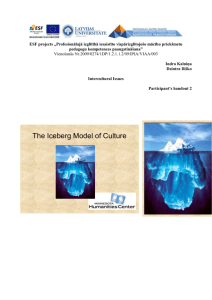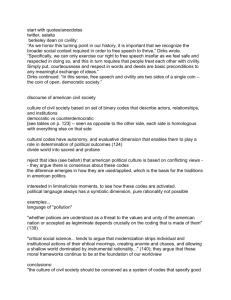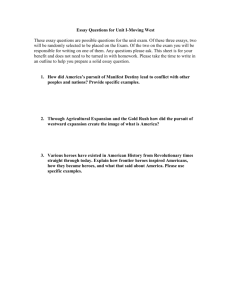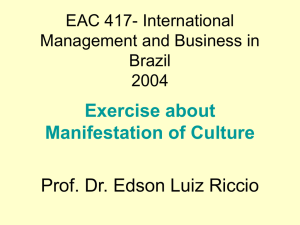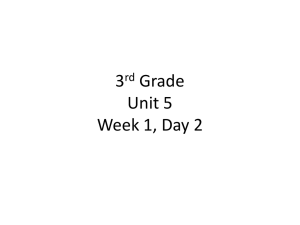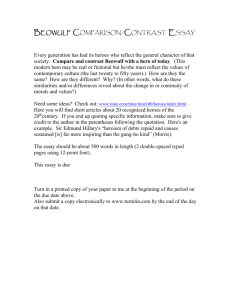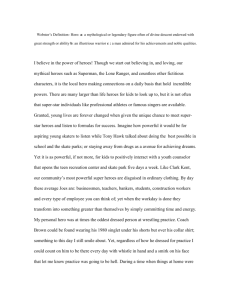Understanding Organizational Culture: A Key Leadership Asset
advertisement
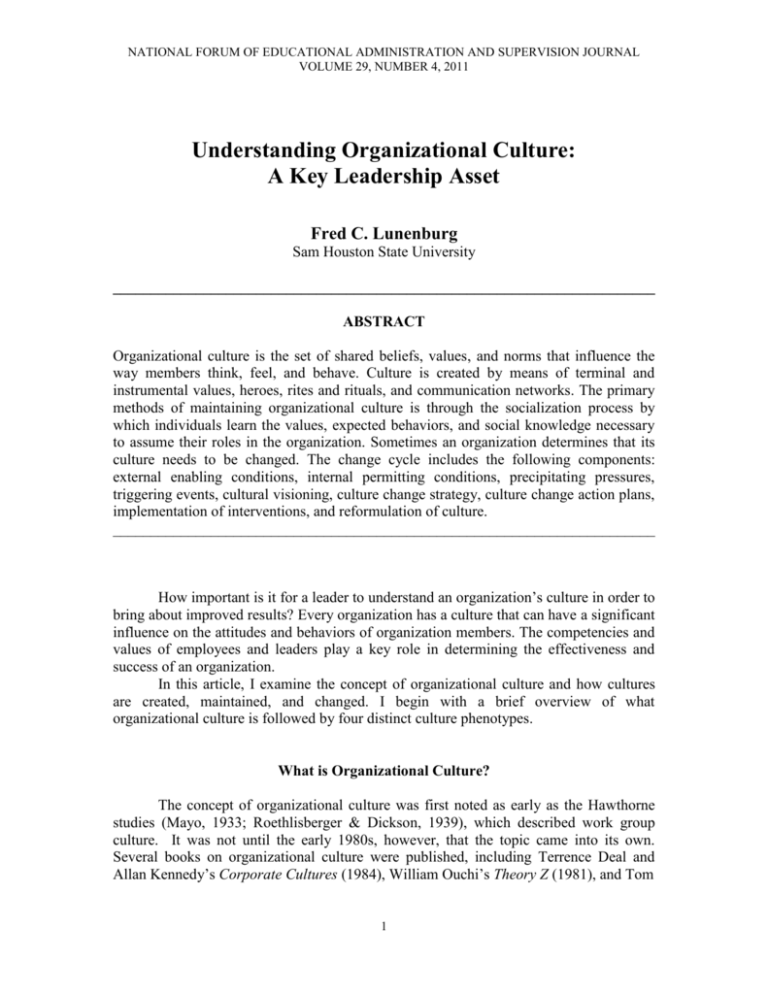
NATIONAL FORUM OF EDUCATIONAL ADMINISTRATION AND SUPERVISION JOURNAL VOLUME 29, NUMBER 4, 2011 Understanding Organizational Culture: A Key Leadership Asset Fred C. Lunenburg Sam Houston State University ________________________________________________________________________ ABSTRACT Organizational culture is the set of shared beliefs, values, and norms that influence the way members think, feel, and behave. Culture is created by means of terminal and instrumental values, heroes, rites and rituals, and communication networks. The primary methods of maintaining organizational culture is through the socialization process by which individuals learn the values, expected behaviors, and social knowledge necessary to assume their roles in the organization. Sometimes an organization determines that its culture needs to be changed. The change cycle includes the following components: external enabling conditions, internal permitting conditions, precipitating pressures, triggering events, cultural visioning, culture change strategy, culture change action plans, implementation of interventions, and reformulation of culture. ________________________________________________________________________ How important is it for a leader to understand an organization’s culture in order to bring about improved results? Every organization has a culture that can have a significant influence on the attitudes and behaviors of organization members. The competencies and values of employees and leaders play a key role in determining the effectiveness and success of an organization. In this article, I examine the concept of organizational culture and how cultures are created, maintained, and changed. I begin with a brief overview of what organizational culture is followed by four distinct culture phenotypes. What is Organizational Culture? The concept of organizational culture was first noted as early as the Hawthorne studies (Mayo, 1933; Roethlisberger & Dickson, 1939), which described work group culture. It was not until the early 1980s, however, that the topic came into its own. Several books on organizational culture were published, including Terrence Deal and Allan Kennedy’s Corporate Cultures (1984), William Ouchi’s Theory Z (1981), and Tom 1 NATIONAL FORUM OF EDUCATIONAL ADMINISTRATION AND SUPERVISION JOURNAL 2____________________________________________________________________________________ Peters and Robert Waterman’s In Search of Excellence (1982). These books popularized organizational culture, and researchers began in earnest to study the topic. Organizational theorists indicated that these cultures were real. They acknowledged that organizations have personalities just like people. For example, organizations can be flexible or rigid, supportive or unfriendly, innovative or conservative. Organization theorists documented the important role that culture plays in the lives of organization members. When you tell people where you work, they will ask you: What is it like there? The description you give likely will have a lot to do with the organization’s culture. In calculating your response to the question, you will describe the kinds of people who work at your school/school district. You will describe the work atmosphere on a typical day. You will describe the facilities in your work-place and how you feel people are treated. You will describe what it is that defines “success” at your school/school district. These responses give clues that help outsiders understand what your school/school district’s culture is really like. To provide you with a more complete understanding of organizational culture, it is necessary to define the concept in more detail. Definition and Characteristics The culture of an organization is all the beliefs, feelings, behaviors, and symbols that are characteristic of an organization. More specifically, organizational culture is defined as shared philosophies, ideologies, beliefs, feelings, assumptions, expectations, attitudes, norms, and values (Schein, 2011). While there is considerable variation in the definitions of organizational culture, it appears that most contain the following characteristics: Observed behavioral regularities. When organization members interact, they use common language, terminology, and rituals and ceremonies related to deference and demeanor. Norms. Standards of behavior evolve in work groups that are considered acceptable or typical for a group of people. The impact of work-group behavior, sanctioned by group norms, results in standards and yardsticks. Dominant values. An organization espouses and expects its members to share major values. Typical examples in schools are high performance levels of faculty and students, low absence and dropout rates of students, and high efficiency. Philosophy. Policies guide an organization’s beliefs about how employees and clients are to be treated. For example, most school districts have statements of philosophy or mission statements. Rules. Guidelines exist for getting along in the organization, or the “ropes” that a newcomer must learn in order to become an accepted member. FRED C. LUNENBURG ____________________________________________________________________________________3 Climate. This is an overall atmosphere that is conveyed in an organization by the physical layout and the way in which members interact with clients or other outsiders. None of these characteristics can by itself represent the essence of organizational culture. However, the characteristics taken collectively reflect and give meaning to the concept of organizational culture. Steinhoff and Owens (1989) have developed four distinctive culture phenotypes that demonstrate how these characteristics can be mixed to create highly diverse organizational cultures likely to be found in public schools (see Table 1). Table 1 Four Distinctive Culture Phenotypes Family Culture This school can be described using metaphors such as family, home, or team. The principal in this school can be described as a parent (strong or weak), nurturer, friend, sibling, or coach. In this school, “concern for each other is important as well as having a commitment to students above and beyond the call of duty.” Everyone should be willing to be a part of the family and pull their own weight. The school as family then is nurturing and friendly, often cooperative and protective. Machine Culture This school can be described using the metaphor of the machine. Metaphors for the school include well-oiled machines, political machines, beehives of activity, or rusty machines. Metaphors for the principal range from workaholic, Paul Bunyan, and The General to Charlie Brown and the slug. The school as machine then is viewed purely in instrumental terms. The driving force appears to come from the structure of the organization itself, and administrators are described in terms of their varying ability to provide maintenance inputs. However, unlike those of the family culture, its mission is protection rather than warmth. Cabaret Culture Metaphors such as a circus, a Broadway show, a banquet, or a well-choreographed ballet performed by well-appreciated artists describe this school. The principal is seen as a master of ceremonies, a tightrope walker, and a ring master. Teachers in these schools experience many of the same group-binding social activities as do their colleagues in the family culture school. The essential difference is that, in this culture, relationships center on performances and the reactions of the audience. There is great pride in the artistic and intellectual quality of one’s teaching, which is carried out under the watchful eye of the maestro. At the cabaret the show must go on! “Little Shop of Horrors” Culture This school can be described as an unpredictable, tension-filled nightmare having the characteristics of a war zone or revolution. “One never knows whose head will roll next.” Teachers report their schools as closed boxes or prisons. The principal is a self-cleansing statue ready to offer up a sacrifice if it will maintain his position. Administrators in this school are seen as individuals whose main function is to keep things smoothed over. Others have a Napoleon complex that promotes dominance and control or Jekyll-Hyde personalities that promote a walking-on-eggs style of adaptive behavior among faculty. Unlike the family and cabaret cultures, teachers in this school lead isolated lives; there is little social activity. One is expected to conform and to smile when appropriate. Verbal abuse among faculty is common, and closeness seems to be melting away. This culture is cold, hostile, and paranoid. “Almost anything can get you—and it often does.” ______________________________________________________________________________ NATIONAL FORUM OF EDUCATIONAL ADMINISTRATION AND SUPERVISION JOURNAL 4____________________________________________________________________________________ Creating Organizational Culture Deal and Kennedy (1984) identified four dimensions of organizational culture: values, heroes, rites and rituals, and communication networks. These four dimensions play a key role in creating organizational cultures. Values What are values, and how do they affect behavior? Values are general criteria, standards, or principles that guide the behavior of organization members (Jones, 2010). There are two kinds of values: terminal and instrumental. A terminal value is a desired outcome that organization members seek to achieve. Schools typically adopt any of the following as terminal values: quality, excellence, and success (Bulach, Lunenburg, & Potter, 2012). An instrumental value is a desired mode of behavior. Modes of behavior that most schools advocate include working hard, providing excellent teaching, respecting student diversity, being creative, teamwork, and maintaining high standards (Lunenburg & Ornstein, 2012). Thus, an organization’s culture consists of outcomes that the organization seeks to achieve (its terminal values) and the modes of behavior the organization encourages (its instrumental values). Ideally, instrumental values help the organization achieve its terminal values. For example, a school/school district whose culture emphasizes the terminal value of high achievement for all students might attain this outcome by encouraging instrumental values like working hard to reach all students. This combination of terminal and instrumental values leads to school/school district success. Schools are able to achieve success only when shared values exist among group members. Shared values can provide a strong organizational identity, enhance collective commitment, provide a stable social system, and reduce the need for bureaucratic controls. The following guidelines are recommended to achieve shared values (Schermerhorn, Hunt, & Osborn, 2008, p. 372): A widely shared understanding of what the school stands for, often embodied in slogans; A concern for individuals over rules, policies, procedures, and adherence to job duties; A well-understood sense of the informal rules and expectations so that group members and administrators understand what is expected of them; A belief that what group members and administrators do is important, and that it is important to share information and ideas; A recognition of heroes, whose actions illustrate the organization’s shared philosophy and concerns; A belief in rites and rituals as important to organization members as well as to building a common identity. FRED C. LUNENBURG ____________________________________________________________________________________5 Heroes Most successful organizations have their heroes. Heroes are born and created. The born hero is the visionary institution builder like Henry Ford, founder of the Ford Motor Company, Walt Disney, creator of Disney Studios and theme parks, and Mary Kay Ash, founder of Mary Kay Cosmetics. Created heroes, on the other hand, are those the institution has made by noticing and celebrating memorable moments that occur in the day-to-day life of the organization. Thomas Watson, former head of IBM, is an example of a situation hero. Other well-known heroes include Lee Iacocca at Chrysler, Sam Walton at Wal-Mart, and Vince Lombardi, the legendary coach of the Green Bay Packers. Heroes perpetuate the organization’s underlying values, provide role models, symbolize the organization to others, and set performance standards that motivate participant achievement. In many schools, local heroes and heroines—exemplars of core values—provide role models of what everyone should be striving for in the school/school district. These deeply committed staff come in early; are always willing to meet with students; and are constantly upgrading their skills. Rites and Rituals Another key aspect in creating organizational cultures is the everyday activities and celebrations that characterize the organization. Most successful organizations feel that these rituals and symbolic actions should be managed. Through rites and rituals, recognition of achievement is possible. The Teacher of the Year Award and National Merit Schools are examples. Similarly, a number of ceremonial rituals may accompany the appointment of a new superintendent of schools, including press and other announcements, banquets, meetings, and speeches. Some organizations have even created their own reward rituals. At Hollibrook Elementary School in Spring Branch, Texas, rites and rituals reinforce student learning. Under the leadership of the principal and faculty, and supported through ties to the Accelerated Schools Model, the school developed numerous traditions to create a powerful professional culture and foster increased student success. For example, faculty meetings became a hotbed of professional dialogue and discussion of practice and published research. “Fabulous Friday” was created to provide students with a wide assortment of courses and activities. A “Parent University” furnishes courses and materials while building trust between the school and the largely Hispanic community. Norms of collegiality, improvement, and connection reinforce and symbolize what the school is about. Communication Networks Stories or myths of heroes are transmitted by means of the communications network. This network is characterized by various individuals who play a role in the culture of the organization. Each institution has storytellers who interpret what is going on in the organization. Their interpretation of the information influences the perceptions NATIONAL FORUM OF EDUCATIONAL ADMINISTRATION AND SUPERVISION JOURNAL 6____________________________________________________________________________________ of others. Priests are the worriers of the organization and the guardians of the culture’s values. These individuals always have time to listen and provide alternative solutions to problems. Whisperers are the powers behind the throne because they have the boss’s ear. Anyone who wants something done will go to the whisperer. Gossips carry the trivial day-to-day activities of the organization through the communications network. Gossips are very important in building and maintaining heroes. They embellish the heroes’ past feats and exaggerate their latest accomplishments. And, finally, spies are buddies in the woodwork. They keep everyone well informed about what is going on in the organization. Each of these individuals plays a key role in building and maintaining an organization’s culture. It should be noted that the names used here are those ascribed by Deal and Kennedy (1984) to emphasize the importance of communication networks in creating an institution’s organizational culture. Maintaining Organizational Culture Once an organizational culture is created, a number of mechanisms help solidify the acceptance of the values and ensure that the culture is maintained or reinforced (often referred to as organizational socialization). These mechanisms, illustrated in Figure 1, are the following steps for socializing employees (Pascale, 1985): Start 1: Selection of Staff 7: Consistent Role Models Deselect 2: Orientation 3: Job Mastery 6: Reinforcing Folklore 5:Adherence to Values Figure 1. The process of organizational socialization. 4: Rewards and Control Systems FRED C. LUNENBURG ____________________________________________________________________________________7 Step 1: Selection of Staff The socialization process starts with the careful selection of staff. Trained recruiters use standardized procedures and focus on values that are important in the culture. Those candidates whose personal values do not fit with the underlying values of the organization are given ample opportunity to opt out (deselect). Step 2: Orientation After the chosen candidate is hired, considerable training ensues to expose the person to the culture. Humility-inducing experiences, which cause employees to question prior beliefs and values, are assigned, thereby making new employees more receptive to the values of the new culture. Many organizations give newly hired employees more work than they can reasonably handle and assign work for which the individual is overqualified. For example, a new faculty member of a university may be assigned undesirable tasks, which senior professors of the department do not wish to perform: teaching the basic courses, off-campus assignments, assignment to several committees, heavy advisement loads, field work, and assignment to an inequitable number of doctoral committees. The message conveyed to the newcomer is, “You must pay your dues.” Step 3: Job Mastery Whereas Step 2 is intended to foster cultural learning, Step 3 is designed to develop the employee’s technological knowledge. As employees move along a career path, the organization assesses their performance and assigns other responsibilities on the basis of their progress. Frequently, organizations establish a step-by-step approach to this career plan. For example, some states have adopted a three-step career ladder process for teachers: (a) instructors, (b) professional teachers, and (c) career professional-teachers. Another model consists of four steps: (a) licensed teachers, (b) certified teachers, (c) advanced certified teachers, and (d) lead teachers. Step 4: Reward and Control Systems The organization pays meticulous attention to measuring operational results and to rewarding individual performance. Reward systems are comprehensive, consistent, and focus on those aspects of the organization that are tied to success and the values of the culture. For example, a school district will specify the factors that are considered important for success. Operational measures are used to assess the factors, and performance appraisals of employees are tied to the accomplishment of these factors. Promotions and merit pay are determined by success on each of the predetermined critical factors. For instance, those school administrators who violate the culture are often transferred or given a relatively innocuous staff position at central office. These administrators are now “off their career tracks,” which can inhibit their promotion in the organization. This is the typical pattern used in large bureaucratic school districts as an alternative to firing the administrator. NATIONAL FORUM OF EDUCATIONAL ADMINISTRATION AND SUPERVISION JOURNAL 8____________________________________________________________________________________ Step 5: Adherence to Values As personnel continue to work for the organization, their behavior closely matches the underlying values of the culture. Identification with underlying values helps employees reconcile personal sacrifices caused by their membership in the organization. Personnel learn to accept the organization’s values and place their trust in the organization not to hurt them. For instance, school administrators work long hours on a multiplicity of fragmented tasks for which they sometimes receive little recognition from their superiors, subordinates, and the community. They sometimes endure ineffective school board members and supervisors and job assignments that are undesirable and inconvenient. Identification with the common values of the organization allows these administrators to justify such personal sacrifices. Step 6: Reinforcing Folklore Throughout the socialization process, the organization exposes its members to rites and rituals, stories or myths, and heroes that portray and reinforce the culture. For example, in one educational institution, the story is told of an administrator who was fired because of his harsh handling of subordinates. The administrator had incorrectly believed a myth that being “tough” with his subordinates would enhance himself in the eyes of his superiors. The organization deemed such managerial behavior to be inconsistent with its organizational philosophy of cultivating good interpersonal relationships and high levels of morale and job satisfaction among all its employees. Step 7: Consistent Role Models Those individuals who have performed well in the organization serve as role models to newcomers to the organization. By identifying these employees as symbolizing success, the organization encourages others to do likewise. Role models in strong-culture institutions can be thought of as one type of ongoing staff development for all organizational members. Changing Organizational Culture The same processes used to maintain an organization’s culture may be used to change it. The following components are likely to be involved in the change cycle (Frost, 1991): (a) external enabling conditions, (b) internal permitting conditions, (c) precipitating pressures, (d) triggering events, (e) cultural visioning, (f) cultural change strategy, (g) culture change action plans, (h) implementation of interventions, and (i) reformulation of culture (see Figure 2). FRED C. LUNENBURG ____________________________________________________________________________________9 Organization or Subunit Culture Resulting in Reformulation of Under External Enabling Conditions and Internal Permitting Conditions Whose Interventions Are Implemented When Precipitating Pressures Exist Translated into Inducement, Managements, and Stabilization Action Plans Experiences Triggering Events Guiding the Developmental of a Culture Change Strategy That Sometimes Lead to Agents Engaging in Culture Visioning Figure 2. The change cycle of organizational culture. External Enabling Conditions Enabling conditions, if they exist, indicate that the environment will be supportive of culture change. Such conditions are in the external environment and impact the organization. In a school setting, examples include scarcity or abundance of students, stability or instability of the external environment, and resource concentration or dispersion. In combination, these external enabling conditions determine the degree of threat to the organization’s input sources (information, people, and materials). Internal Permitting Conditions To increase the likelihood of organizational culture change, four internal permitting conditions must exist: (a) a surplus of change resources (administrative time and energy, financial resources, and the like that are available to the system beyond those needed for normal operating); (b) system readiness (willingness of most members to live with anxiety that comes with anticipated uncertainty that is change); (c) minimal coupling (coordination and integration of system components); and (d) change-agent power and leadership (the ability of administrators to envision alternative organizational futures). NATIONAL FORUM OF EDUCATIONAL ADMINISTRATION AND SUPERVISION JOURNAL 10____________________________________________________________________________________ Precipitating Pressures Four factors that precipitate organizational culture change include (a) atypical performance; (b) pressure exerted by stakeholders; (c) organizational growth or decrement in size, membership heterogeneity, or structure complexity; and (d) real or perceived crises associated with environmental uncertainty. Triggering Events Culture change usually begins in response to one or more triggering events. Examples include (a) environmental calamities or opportunities such as natural disasters, economic recession, innovations, or discovery of new markets; (b) administrative crises such as a major shakeup of top administrators, an inappropriate strategic decision, or a foolish expenditure; (c) external revolution such as mandated desegregation, PL101-476, Title IX, or the No Child Left Behind Act of 2001; and (d) internal revolution such as the installation of a new administrative team within the organization. Cultural Visioning Creating a vision of a new, more preferred organizational culture is a necessary step toward that culture’s formation. Leaders survey the beliefs, values, assumptions, and behaviors of the organization’s existing culture. They seek to anticipate future conditions and create an image of the organization within that future. Culture Change Strategy Once a new cultural vision exists, an organization needs a strategy to achieve that culture. Such a strategy outlines the general process of transforming the present culture into the new one. Culture Change Action Plans A series of explicit action plans for the inducement, administration, and stabilization of change make a change strategy known. Inducement action planning involves stimulating organizational members to a change or countering resistance to change. Administrative action planning involves outlining interventions and mobilizing change agents. Stabilization action planning focuses on the institutionalization of culture change; that is, establishing the existence of the new culture as an accepted fact. Implementation of Interventions An organization selects culture change interventions based on the ecology of a particular organization for each action plan phase and the change agent’s competencies in implementing them. FRED C. LUNENBURG ____________________________________________________________________________________11 Reformulation of Culture When implemented, the intervention plans result in a reformulated culture. Any comprehensive change involves an attempt to change the culture of the organization. Conclusion Organizational culture is the set of shared beliefs, values, and norms that influence the way members think, feel, and behave. Culture is created by means of terminal and instrumental values, heroes, rites and rituals, and communication networks. The primary methods of sustaining organizational culture is through the socialization process by which individuals learn the values, expected behaviors, and social knowledge necessary to assume their roles in the organization. Sometimes an organization determines that its culture needs to be changed. The change cycle includes the following components: external enabling conditions, internal permitting conditions, precipitating pressures, triggering events, cultural visioning, culture change strategy, culture change action plans, implementation of interventions, and reformulation of culture. References Bulach, C., Lunenburg, F. C., & Potter, L. (2012). Creating a culture for high-performing schools: A comprehensive approach to school reform (2nd ed.). Lanham, MD: Rowman & Littlefield. Deal, T., & Kennedy, A. (1984). Corporate cultures: The rites and rituals of corporate life. Reading, MA: Addison-Wesley. Frost, P. (1991). Reframing organizational culture. Thousand Oaks, CA: Sage. Jones, G. R. (2010). Organizational theory, design, and change (5th ed.). Upper Saddle River, NJ: Prentice Hall. Mayo, E. (1933). The human problems of an industrial civilization. New York, NY: Macmillan. Lunenburg, F. C., & Ornstein, A. O. (2012). Educational administration: Concepts and practices. Belmont, CA: Cengage Wadsworth. Ouchi, W. (1981). Theory Z. Reading, MA: Addison-Wesley. Pascale, R. T. (1985). Paradox of corporate culture: Reconciling ourselves to socialization. California Management Review, 27, 38-64. Peters, T., & Waterman, R. (1982). In search of excellence. New York: Harper & Row. Roethlisberger, F. J., & Dickson, W. J. (1939). Management and the worker. Cambridge, MA: Harvard University Press. Schein, E. H. (2011). Leadership and organizational culture. New York, NY: Wiley. Schermerhorn, J. R., Hunt, J. G., & Osborn, R. N. (2008). Organizational behavior (10th ed.). New York, NY: Wiley. NATIONAL FORUM OF EDUCATIONAL ADMINISTRATION AND SUPERVISION JOURNAL 12____________________________________________________________________________________ Steinhoff, C. R., & Owens, R. G. (1989). The organizational culture assessment inventory: A metaphorical analysis in educational settings. Journal of Educational Administration, 27, 17-23.
